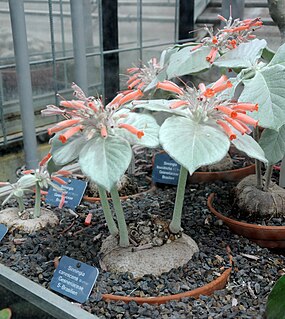
Catalpa, commonly called catalpa or catawba, is a genus of flowering plants in the family Bignoniaceae, native to warm temperate and subtropical regions of North America, the Caribbean, and East Asia.

Eulophia, commonly known as corduroy orchids, is a genus of about two hundred species of flowering plants in the orchid family, Orchidaceae. Most Eulophia orchids are terrestrial but some are deciduous while others are evergreen. They either have an underground rhizome or pseudobulbs on the surface and those species with leaves have them on the end of a fleshy stem. The flowers are arranged on a thin flowering spike, the flowers having sepals which are larger than the petals. The genus is widely distributed but most species are found in Africa and Asia, usually growing in shady places with grass or shrubs in forests.

Lobelia is a genus of flowering plants comprising 415 species, with a subcosmopolitan distribution primarily in tropical to warm temperate regions of the world, a few species extending into cooler temperate regions. They are known generally as lobelias.

Platycladus is a monotypic genus of evergreen coniferous trees in the cypress family Cupressaceae, containing only one species, Platycladus orientalis, also known as Chinese thuja, Oriental arborvitae, Chinese arborvitae, biota or Oriental thuja. It is native to northeastern parts of East Asia and North Asia, but is also now naturalised as an introduced species in other regions of the Asian continent.

Gesneriaceae, the gesneriad family, is a family of flowering plants consisting of about 152 genera and ca. 3,540 species in the tropics and subtropics of the Old World and the New World, with a very small number extending to temperate areas. Many species have colorful and showy flowers and are cultivated as ornamental plants.

Solanum pseudocapsicum is a nightshade species with mildly poisonous fruit. It is commonly known as the Jerusalem cherry, Madeira winter cherry, or, ambiguously, "winter cherry". These perennials can be grown decoratively as house plants, but in some areas of South Africa, India, Australia and New Zealand it is regarded as a weed.

Gloxinia is a genus containing three species of tropical rhizomatous herbs in the flowering plant family Gesneriaceae. The species are primarily found in the Andes of South America, but Gloxinia perennis is also found in Central America and the West Indies, where it has probably escaped from cultivation.

Ceiba speciosa, the floss silk tree, is a species of deciduous tree native to the tropical and subtropical forests of South America. It has several local common names, such as palo borracho or árbol del puente, samu'ũ or paineira. In Bolivia, it is called toborochi, meaning "tree of refuge" or "sheltering tree". It belongs to the same family as the baobab and the kapok. Another tree of the same genus, Ceiba chodatii, is often referred to by the same common names.

Seemannia is a New World genus in the flowering plant family Gesneriaceae. There are four species in the genus, primarily found in the Andean regions of South America. The name honors the German botanist Berthold Carl Seemann.

Sinningia is a genus of flowering plants in the family Gesneriaceae. It is named after Wilhelm Sinning (1792–1874), a gardener of the Botanische Gärten der Friedrich-Wilhelms-Universität Bonn. There are about 65 species of tuberous herbaceous perennials, all occurring in Central and South America, with the greatest concentration of species occurring in southern Brazil.

Chaenomeles speciosa, the flowering quince, Chinese quince, or Japanese quince, is a thorny deciduous or semi-evergreen shrub native to eastern Asia. It is taller than another commonly cultivated species, C. japonica, usually growing to about 2 m. The flowers are usually red, but may be white or pink. The fruit is a fragrant but hard pome that resembles a quince.
Benjamin Peter Gloxin (1765–1794) was a German physician and botanical writer who lived in Colmar. He is commemorated by the Brazilian genus Gloxinia and Sinningia speciosa, which is commonly called Gloxinia in the horticulture trade. In 1791, he was elected to the American Philosophical Society.

Gambelia speciosa, previously classified as Galvezia speciosa, is commonly known as showy island snapdragon or showy greenbright.

Verbena bonariensis, the purpletop vervain, clustertop vervain, Argentinian vervain, tall verbena or pretty verbena, is a member of the verbena family cultivated as a flowering annual or herbaceous perennial plant. In USA horticulture, it is also known by the ambiguous names purpletop and South American vervain. For the misapplication "Brazilian verbena" see below.

Gloxinia perennis is a species of tropical rhizomatous herbaceous flowering plant belonging to the family Gesneriaceae. It is sometimes known as "Canterbury bells".

Lophospermum erubescens, known as Mexican twist or creeping gloxinia, is a climbing or sprawling herbaceous perennial plant, native to the Sierra Madre Oriental mountains of Mexico, where it is found along forest margins or canyon walls. It climbs by means of twining leaf stalks. Wild plants have pink and white tubular flowers, although other colours are found in cultivation. It has been cultivated as an ornamental plant since at least 1830. Although not frost-hardy, it will survive if its base and roots are protected from freezing in the winter. It has escaped from cultivation and become naturalized in tropical and subtropical areas of the world.

The Gesnerioideae are a subfamily of plants in the family Gesneriaceae: based on the type genus Gesneria. Although genera typically originate in the New World, some species have become widely distributed as ornamental plants.

Sinningia canescens, called the Brazilian edelweiss, is a species of flowering plant in the genus Sinningia, native to southeastern and southern Brazil. A tuberous perennial reaching 30 cm (12 in), it has gained the Royal Horticultural Society's Award of Garden Merit as a hothouse ornamental.

Incarvillea delavayi, the so‑called hardy gloxinia or flowering fern, is a species of flowering plant in the family Bignoniaceae, native to western Sichuan and northwest Yunnan provinces of China. The true Gloxinia are members of the Gesneriaceae, while true ferns are flowerless plants which reproduce through spores.


















